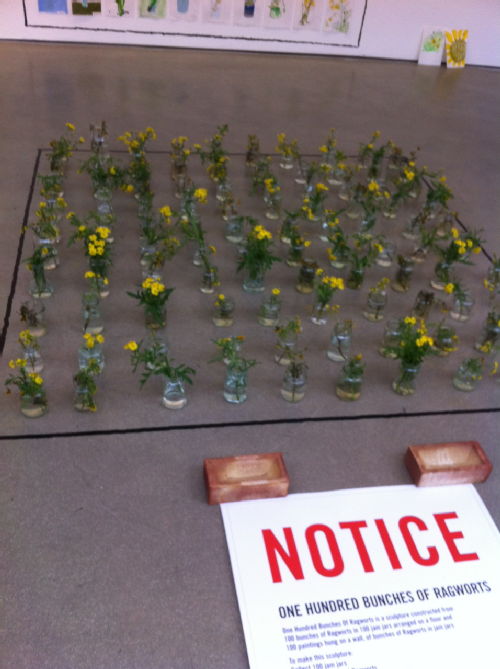All entries for Thursday 26 April 2012
April 26, 2012
Ragworts
Writing about web page http://www.sitegallery.org/archives/4371
On Friday I went to the opening of Ragworts, an exhibition of work by Bill Drummond at Site Gallery in Sheffield. Ragworts are the brash yellow flowers which grow like weeds on the side of railways and motorways - Drummond’s symbol for the beauty that breaks through the cracks in the pavement, the artist who thrives in spite of not because of the city, the art that flares up unexpectedly, decays and dies. The exhibition is a meditation on the fleeting nature of art, fame and money. As record buyers of a certain age will remember, Drummond achieved his moment of fame as half of the duo KLF, reaching number one in the UK singles chart in the 1990s, and permanent notoriety as the man who burned a million pounds on a Scottish island, accompanied by a journalist and a video camera. The show imagines a world without music, interrupted by lyrics of songs Drummond wrote for ‘The Seventeen’ a temporary choir of random non-singers – a solitary meander through the city, the echoes of shouts under a bridge, bus journeys, an all-day breakfast in a greasy spoon. It’s a more accessible and thoughtful take on the age-old conundrum of art, fame, money and death currently being played out by Damien Hirst in London. It’s also – like Hirst – often very funny. One visitor laughs out loud as Drummond’s lyric fantasises about lobbing a Molotov cocktail over the wall of a new Tescos development – or gently dropping a bottle in the bottle bank. This is, it turns out, a former member of The Seventeen – the choir has no permanent membership and no recordings. Other visitors include some of the schoolchildren who painted 100 pictures of ragworts, framed on the wall above 100 jam jars of ragwort flowers (gathered by Drummond from the central reservation of the M1). The exhibition looks great – there are big posters of the lyrics on the floor, a video showing Drummond making and talking about his work – and lots of yellow ragworts.
In the book to accompany the exhibition, Drummond is scathing about the Arts Council, about Sheffield’s cultural industries quarter and the whole machinery of ‘official’ culture. Drummond doesn’t want urban regeneration – he wants degeneration. He acknowledges some inconsistencies in this position. As the artist formerly known as a pop star, he is now dependent on artist (or composer) residencies and subsidised galleries like Site show his work. Privately, I’m told he admits it is difficult to explain the million pound bonfire to his children (if you’ve got kids, don’t try this at home), and he acknowledges that his diatribe against the Arts Council sounds uncomfortably like the rhetoric of the American right – something he has ‘yet to square’. Yet there is a grumpy integrity to his position. And coming from a Centre for Cultural Policy Studies where many of us are suspicious of the machinery and rhetoric of cultural policy, I find Drummond’s argument about the dead hand of state-approved culture perversely resonant. I don’t quite agree that well meaning arts officers and bureaucrats are turning art into propaganda. It’s more the flipside of this rhetoric which strikes a chord: Drummond’s feeling for the ephemeral, excluded, everyday quality of art. He’s alert to the poetry of street sounds and the flashes of unexpected beauty which captivate us for a moment then vanish. Whether it’s the three minutes of Tammy Wynette singing obscure lyrics over a perfect pop single, the sound of breaking glass, the flare of a ragwort blossoming in a city street or the smell of burning money, ‘culture’ is not permanent. Like fame and success, it burns brightly and then we’re left with the dead remnants. And Drummond describes a particular way of listening to and observing these sounds and colours, an imaginative twisting of random events and experiences into stories and pictures. Culture is not the preserve of special people or places but it does depend on a special kind of attention. Beauty is all around us, but it’s also in the eye (or ear) of the beholder.
Across the road from Site Gallery stands the old National Centre for Popular Music – now ‘The Hubs’, home to Sheffield Hallam Students’ Union. The old much-maligned Pop Centre is a stark monument to the difficulties of trying to pin down the popular culture of the moment, to turn a cultural act into a cultural quarter, to make art into history. The view of the Hubs across the street from Drummond and his ragworts exposes the gap between the short life of popular culture and the deadly rictus of cultural policy (however well intentioned). In Drummond’s vision, beauty is temporary and ugliness is permanent. And when we find ourselves ‘seething’ against the deadly platitudes of modern urban life (something Drummond does a lot of), the sound of a sparrow singing or the colourful petals of a ragwort – and the gathered remnants of these feelings in Site’s exhibition – can help us feel a little bit happier, more connected and more alive.

 Christopher Bilton
Christopher Bilton

 Please wait - comments are loading
Please wait - comments are loading

 Loading…
Loading…